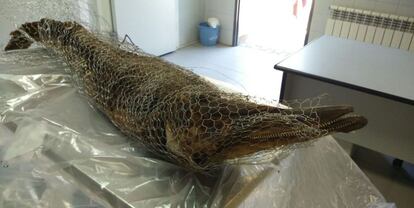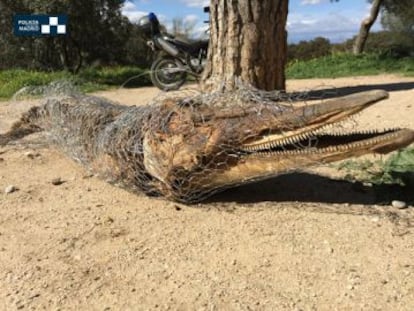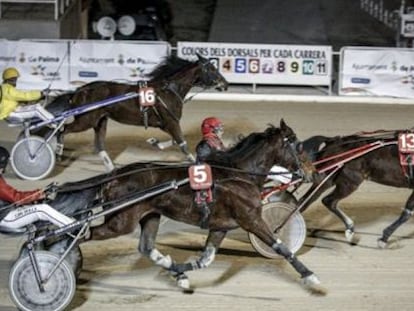The true story behind the dolphin corpse found in Madrid’s biggest park
The police believe that the mammal was the victim of a network of animal traffickers

It was around 3.30pm on Tuesday afternoon when a resident of the nearby Latina neighborhood, who prefers to remain anonymous, was taking a walk with his two dogs in Madrid’s Casa de Campo, the biggest park in the capital. But César, his three-year-old Daschund, suddenly ran away from him toward some scrubland. The animal began to bark and nervously scratch at the ground.
The man approached to see what was happening and at that moment found the semi-buried head of what looked like another dog. He pulled at it and was immediately surrounded by a strong smell of rotting flesh. He didn’t know it, but he had found the body of a young dolphin, which was wrapped in chicken wire and had been buried there around a year ago – more than 300 kilometers from the nearest sea.
I thought to start it might be a greyhound due to the teeth it had, and that whoever would abandon an animal like this must be a very bad person
Investigators believe that the animal may have died while being handled by animal traffickers.
The owner of the dog explained this week to EL PAÍS that César was unwilling to leave his discovery. “The first thing I thought was, What is this? I thought it might be a greyhound due to the teeth it had, and that whoever would abandon an animal like this must be a very bad person.”
The dog owner took time to pull the whole body out of the ground. “The smell was very strong,” he said. “It wasn’t like meat or fish. I was completely confused.”
He took some time to get the entire body out, and once he had he still didn’t know what it was. It looked like a crocodile thanks to its long jaw full of teeth. But something wasn’t right – the animal had fins but no legs. Could it be a cetacean? He called the 010 municipal information line. “I don’t know if they believed me,” he said. “They told me they were going to treat the issue as urgent, but no one came along.”
Sign up to our newsletter!
The EL PAÍS English Edition is launching a weekly newsletter. Sign up today to receive a selection of our best stories in your inbox every Saturday morning. For full details about how to subscribe, click here.
As time passed he decided to call the Municipal Police. Concerned they might not believe him, he began by saying that he was looking at a “very strange incident.”
Two officers from the environmental unit appeared in just a few minutes. They quickly called the Environmental Protection Unit (UPMA), given how strange the case was, and on the basis there could be “some kind of robbery or illegal trafficking of animals.”
Police sources told EL PAÍS that they have “a number of lines of inquiry open,” among them the “illegal sale of dolphins or of some of their organs.” The investigators have already confirmed that there are no dolphins missing from Spanish zoos. In Madrid, for example, there are just 11 dolphins and they all live in the nearby Zoo Aquarium.
The biology director of the Madrid zoo, Agustín López, explained that they knew straight away that the animal was not from their park, nor from any other, given that it was a different species. “The cadaver found in the Casa de Campo was in a very bad state, and we couldn’t determine his species, but it was different,” he explained. Each specimen arrives at a zoo or aquarium fully identified and containing a microchip.
López said that it is very unlikely that a cetacean could survive in installations that are inadequate for the job. “You need a lot of space, some very specific characteristics of water, and a lot of filtration.” Such conditions would be impossible to reproduce in a normal swimming pool. The investigators have not ruled out that it could be a river animal, given its very long head and nose.
Police sources told EL PAÍS that they have “a number of lines of inquiry open,” among them the “illegal sale of dolphins or of some of their organs
At the Center for Animal Protection, they have so far confirmed that the animal is “young, and is approximately a meter-and-a-half long.” Its advanced decomposition has impeded, for now, determining the sex and species.
Specialists at the National Museum of Natural Sciences are due to inspect the body this week. “We will take DNA samples and also the morphological measurements,” explained a spokesperson. “We will not carry out an autopsy.”
According to CPA sources, the mammal may have been dead for a year, although the chicken wire – in which it was found wrapped – is more recent. “By its appearance we believe that it was bought specifically to move it to the Casa de Campo.”
If the animal is from the sea, it will have traveled more than 350 kilometers to get to the center of the peninsula, although if it was a river animal, the distance would have been much further – the distance separating the capital from the Amazon or the Ganges.
English version by Simon Hunter.
Tu suscripción se está usando en otro dispositivo
¿Quieres añadir otro usuario a tu suscripción?
Si continúas leyendo en este dispositivo, no se podrá leer en el otro.
FlechaTu suscripción se está usando en otro dispositivo y solo puedes acceder a EL PAÍS desde un dispositivo a la vez.
Si quieres compartir tu cuenta, cambia tu suscripción a la modalidad Premium, así podrás añadir otro usuario. Cada uno accederá con su propia cuenta de email, lo que os permitirá personalizar vuestra experiencia en EL PAÍS.
¿Tienes una suscripción de empresa? Accede aquí para contratar más cuentas.
En el caso de no saber quién está usando tu cuenta, te recomendamos cambiar tu contraseña aquí.
Si decides continuar compartiendo tu cuenta, este mensaje se mostrará en tu dispositivo y en el de la otra persona que está usando tu cuenta de forma indefinida, afectando a tu experiencia de lectura. Puedes consultar aquí los términos y condiciones de la suscripción digital.
More information
Últimas noticias
The complicated life of Francesca Albanese: A rising figure in Italy but barred from every bank by Trump’s sanctions
Half of Scotland is in the hands of 420 property owners
Pinochet’s victims grapple with José Antonio Kast’s rise in Chile
Reinhard Genzel, Nobel laureate in physics: ‘One-minute videos will never give you the truth’
Most viewed
- Pablo Escobar’s hippos: A serious environmental problem, 40 years on
- Why we lost the habit of sleeping in two segments and how that changed our sense of time
- Charles Dubouloz, mountaineering star, retires at 36 with a farewell tour inspired by Walter Bonatti
- Reinhard Genzel, Nobel laureate in physics: ‘One-minute videos will never give you the truth’
- The Florida Keys tourist paradise is besieged by immigration agents: ‘We’ve never seen anything like this’










































